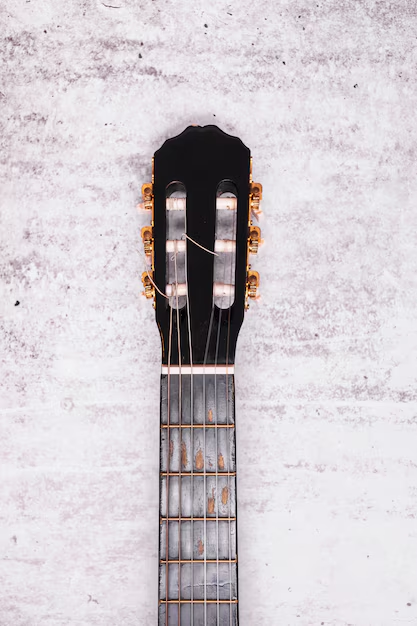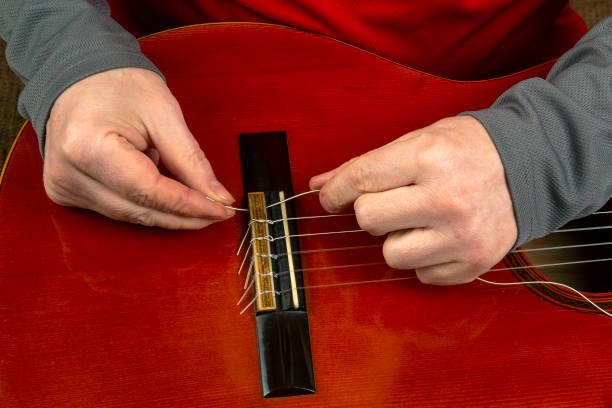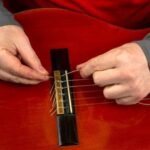Knowing how to fix a broken guitar string can save you time, money, and frustration, but Breaking a guitar string is a habit of every guitarist. Whether it happens during practice, at a performance, or while playing with friends, replacing a string is a straightforward process that every player should know. This guide will take you through each step, from removing the broken string to installing and tuning a replacement. It is making sure your guitar is back to perfect playing condition. We’ll also share expert tips on string maintenance, proper tools to use. After you read you’ll be able to handle a broken string confidently and get back to playing in no time.
Things You’ll Need for Fix a Broken Guitar String:
- Replacement string (same gauge and type)
- String winder (optional but useful)
- Wire cutters or pliers
- Tuner (digital, clip-on, or app-based)
- Soft cloth or fret board cleaner
- Bridge pin puller (for acoustic guitars)
- Small flashlight (optional for better visibility)
- Nut lubricant (or pencil graphite)
Steps for Fix a Broken Guitar String:

1. Prepare Your Workspace
- Find a flat, stable surface to work on, like a table or desk.
- Use a soft cloth or towel to protect your guitar from scratches.
- Gather all your tools and materials to avoid interruptions.
2. Loosen and Remove the Broken String
- Turn the tuning peg to fully loosen the string.
- Carefully unwind it from the tuning post and remove it from the bridge.
- For acoustic guitars, gently use a bridge pin puller to extract the pin holding the string.
3. Inspect the Guitar Thoroughly
- Examine the nut, bridge, and tuning post for sharp edges or burrs that could cause future breakage.
- If needed, smooth sharp spots with fine sandpaper.
- Check the saddle for proper alignment and wear.
4. Clean the Fret board and Guitar Body
- Wipe the fret board with a soft cloth to remove built-up dirt and oils.
- Apply a fret board conditioner, like lemon oil, for rosewood or ebony fret boards.
- Clean the guitar body to keep it looking and feeling fresh.
5. Choose the Correct Replacement String
- Match the replacement string to the rest of your set in terms of gauge and type.
- If unsure, consult your guitar’s manual or consider replacing all strings for tonal consistency.
6. Secure the String at the Bridge
- For acoustic guitars: Insert the ball end of the string into the bridge hole and push the bridge pin down firmly. Make sure the ball end is seated properly.
- For electric guitars: Feed the string through the back of the bridge or tremolo system.
7. Thread the String through the Tuning Post
- Pull the string through the hole in the tuning post, leaving about 2-3 inches of slack.
- Create a small bend in the string to secure it before winding.
8. Wind the String Neatly
- Use a string winder or manually turn the tuning peg to wind the string.
- Ensure the wraps are neat and spiral downward on the post for optimal tension and tuning stability.
- Avoid overlapping the string wraps, as this can lead to slippage.
9. Apply Nut Lubricant
- Apply a small amount of nut lubricant or pencil graphite to the nut slot. This reduces friction and helps prevent future string breakage.
10. Tune the String to Pitch
- Use a tuner to bring the string up to the correct pitch.
- Ensure the string is seated properly in the nut slot and bridge saddle.
11. Stretch the String
- Gently pull the string upward along its length to stretch it.
- Repeat the tuning and stretching process until the string holds its pitch consistently.
12. Trim Excess String
- Use wire cutters to snip off any excess string protruding from the tuning post.
- Leave a small tail (about 1/4 inch) for safety but avoid long, dangling ends.
13. Play and Test
- Play a few scales, chords, or riffs to ensure the string is installed correctly and sounds clear.
- Listen for any buzzing or slipping, which might indicate improper installation.
Maintenance and Tips for Fix a Broken Guitar String:

Replace All Strings Periodically:
- If one string breaks, the others may also be nearing the end of their lifespan. Replacing the entire set ensures consistent tone and tension.
Prevent Corrosion:
- Wipe down your strings after each use with a microfiber cloth to remove sweat and oils.
- Consider coated strings for added durability and resistance to corrosion.
Adjust the Action if Needed:
- High or uneven action can increase string tension, leading to more frequent breakage. Adjust the saddle or truss rod if necessary.
Check the Tuning Stability:
- If the new string keeps going out of tune, check the tuning peg’s tightness and alignment.
Inspect the Bridge and Nut:
- Ensure the bridge pins or saddles are not too tight, as this can cause unnecessary strain on the strings.
Experiment with String Gauges:
- Heavier gauge strings may be more durable, but they require more finger strength. Experiment to find the best fit for your style and guitar.
Keep Spares Handy:
- Always have an extra set of strings, a string winder, and wire cutters in your guitar case or gig bag.
Store Your Guitar Properly:
- Keep your guitar in a case or stand in a temperature-controlled environment to prevent string wear and breakage caused by humidity or temperature fluctuations.
Learn from Professionals:
- Watch video tutorials or consult a guitar technician if you’re unsure about any step in the process.
Check for Structural Issues:
- If strings break frequently, there may be an underlying issue like a misaligned bridge or worn nut slots. Seek professional help to diagnose and fix the problem.
Upgrade Your Hardware:
- Consider locking tuners or better-quality bridge saddles to improve tuning stability and reduce string breakage.
Watch a Video for Fixing a Broken Guitar String:
Conclusion:
Fixing a broken guitar string is a skill every guitarist should learn. You should keep always have in their toolkit. By following all above these steps, you can quickly replace a broken string, restore your guitar’s playability. After this you can improve its overall maintenance. Regularly caring of your strings and keeping the right tools handy will not only help prevent future breaks but also ensure your guitar delivers the best sound possible. With a little practice, fixing a broken guitar string will become second nature.



